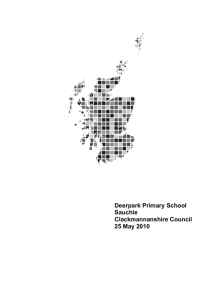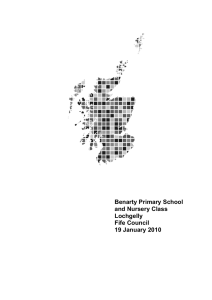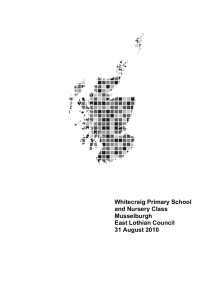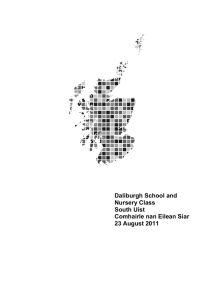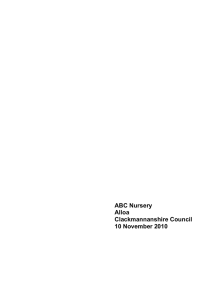St Andrew’s School and Nursery Class Inverurie
advertisement
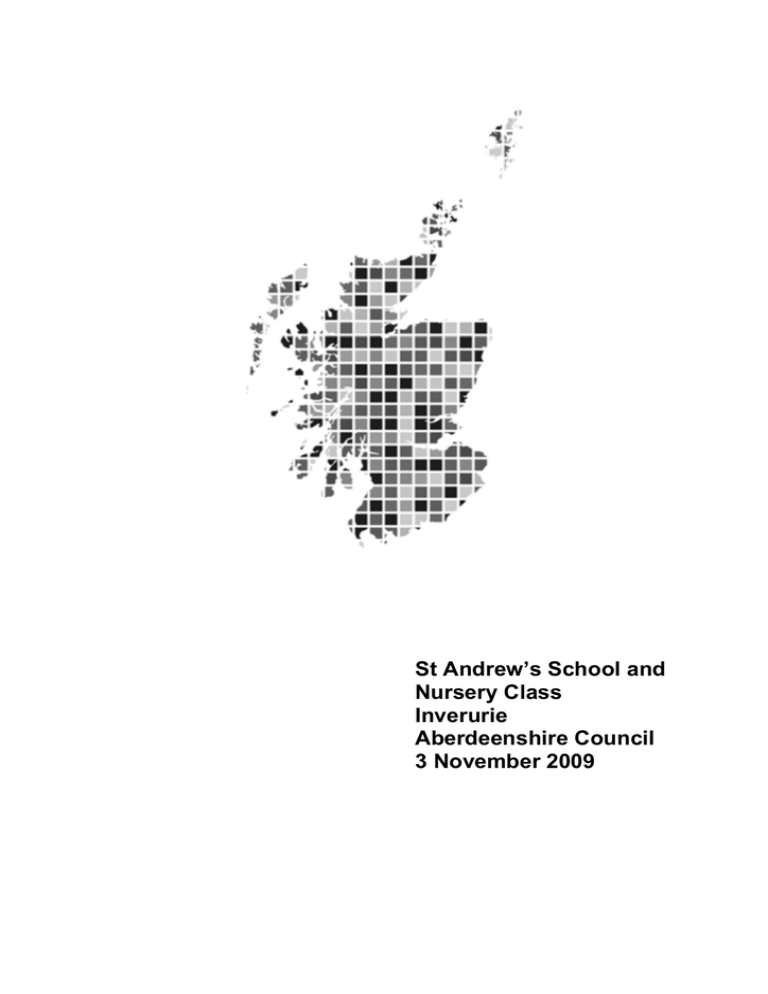
St Andrew’s School and Nursery Class Inverurie Aberdeenshire Council 3 November 2009 HM Inspectorate of Education (HMIE) inspects schools in order to let parents1, young people and the local community know whether their school2 provides a good education. Inspectors also discuss with school staff how they can improve the quality of education. At the beginning of the inspection, we ask the headteacher and staff about the strengths of the school, what needs to improve, and how they know. We use the information they give us to help us plan what we are going to look at. During the inspection, we go into classes and join other activities in which young people are involved. We also gather the views of young people, parents, staff and members of the local community. We find their views very helpful and use them together with the other information we have collected to arrive at our view of the quality of education. This report tells you what we found during the inspection and the quality of education in the school. We describe how well young people are doing, how good the school is at helping them to learn and how well it cares for them. We comment on how well staff, parents and young people work together and how they go about improving the school. We also comment on how well the school works with other groups in the community, including services which support young people. Finally, we focus on how well the school is led and how staff help the school achieve its aims. If you would like to learn more about our inspection of the school, please visit www.hmie.gov.uk. Here you can find analyses of questionnaire returns from young people, parents and staff, and details about young people’s examination performance. We will not provide questionnaire analyses where the numbers of returns are so small that they could identify individuals. Where applicable, you will also be able to find descriptions of good practice in the school and a report on the learning community surrounding the school. 1 Throughout this report, the term ‘parents’ should be taken to include foster carers, residential care staff and carers who are relatives or friends. 2 The term ‘school’ includes the nursery class or classes where appropriate. Contents 1. The school 2. Particular strengths of the school 3. Examples of good practice 4. How well do children and young people learn and achieve? 5. How well do staff work with others to support the learning of children and young people? 6. Are staff, children and young people actively involved in improving their school community? 7. Does the school have high expectations of all children and young people? 8. Does the school have a clear sense of direction? 9. What happens next? 1. The school St Andrew’s School is a non-denominational school with a nursery class. It serves a wide area of central Aberdeenshire. The roll was 100, including 11 in the nursery, when the inspection was carried out in September 2009. The school provides education for children aged from three to 18 years of age who have additional support needs. The children’s additional support needs arise from learning and communication difficulties. Attendance was above the national average in 2007/2008. 1 2. Particular strengths of the school • The quality of relationships which help young people feel safe and happy. • Progress in Curriculum for Excellence and highly creative teaching which helps young people to be actively involved in their learning. • The very close links between the school and the community around it to support learning. • Outstanding leadership of the headteacher, strongly supported by the depute headteachers, which has led to significant improvements across the school. 3. Examples of good practice • Outdoor learning in the nursery. • Whole-school approaches to help young people communicate. • Supporting young people with autism spectrum disorders. 4. How well do children and young people learn and achieve? Learning and achievement In the nursery all children participate enthusiastically in a range of stimulating play activities. They enjoy their experiences. The well-balanced activities within each session help them to make choices 2 about their play and develop their interests. Children respond very well to the sensitive involvement of staff in their play. Across the school almost all young people are highly motivated by their learning and enjoy being at school. They are actively involved in learning and staff encourage them to be as independent as they can be. All young people make choices and almost all know what they need to do to make progress. They are becoming confident at communicating their views using symbols, signing and information and communications technology (ICT). Almost all contribute very well to the life of the school. They help each other in the class and in the playground. A few act as playground monitors and fulfil their responsibilities with enthusiasm. A group cleaned up the garden and helped create a sensory garden. All young people feel that staff seek their views and listen to them. Young people contribute well through the very active pupil council and eco committee. Almost all are healthy and active and they encourage each other to make healthy choices. Across the school young people are achieving success in a broad range of activities. They use the community very well to become more confident at communicating with people beyond the school. These activities include visits to local cafes, restaurants, shops and businesses. All young people learn about contributing to the wider world by raising money for local and national charities. At S5 and S6, young people are taking responsibility for promoting and celebrating World Peace day in their community. They are developing good cooperation and team skills in well-thought-out physical education lessons and in riding for the disabled. Two have been successful in swimming at the Special Olympics. Children in the nursery are developing early communication skills and an understanding of their surroundings. They play confidently and are developing aspects of independence such as brushing their teeth. Across the school all young people are making very good progress in meeting the learning targets set in their individualised educational programmes (IEPs). At P1 to P3, almost all young people are attentive to each other and to adults. They listen well to stories and join in by talking and using gestures. The majority are developing their 3 early writing skills by making patterns with pens. At P4 and P5, children match sounds to pictures and a few match words to pictures. At the secondary stages a few read for pleasure and information. Young people with significant barriers to communication are achieving very well by using their senses to help them learn. Children at P1 and P2 know about colour, numbers and shapes. At P3 to P5 children can use bar graphs to show information they collected. Young people at P6 and P7 use ICT very well to show their understanding of numbers. At S1 to S4 they practise using money in games. Across the school, all young people put their numeracy skills into action in real life situations. In 2008-09 young people at the secondary stages achieved a very broad range of National Qualifications at Access 1 and Access 2. These included mathematics, language, personal development, home economics, art, physical education and social subjects. Curriculum and meeting learning needs The nursery provides children with a wide range of well-planned play experiences that promote the learning and development of each individual child. Staff are taking very good account of Curriculum for Excellence to develop stimulating programmes. In the nursery and across the school there is a very good focus on learning outdoors. Staff plan outdoor activities well so that young people are able to investigate and solve problems. Across the school, young people enjoy a very broad range of activities. Very often these are linked to real-life situations. Staff help young people to make connections across different aspects of their learning. In the autism provision, learning is very well structured and activities are highly suited to the young people. Across the school, teachers are working particularly well to develop reading and numeracy activities. At the secondary stages, young people are developing very good skills for work. Their programme includes very well-planned work experience and very effective links with local colleges. Young people express their opinions about where they would like to go when they leave school. At P6 and P7 as well as at the secondary stages, young people are learning very good skills for life through well-structured residential stays. All young 4 people have access to at least two hours of good quality physical education each week. The school continues to work with the local secondary school to improve links for secondary-aged young people. Staff in the nursery are very responsive to the needs of individual children, and skilled at matching learning activities and resources to these needs. They give high quality support to help children progress. Across the school, staff know young people very well and give them tasks and activities set at the right level of difficulty. They are also very creative at motivating young people so that they are actively involved in learning. Staff in the autism provision have a deep knowledge of autism spectrum disorders. They use this knowledge effectively to make sure young people progress very well in their ability to communicate. The quality of teaching across the school is consistently high. All young people have well prepared IEPs and those who need them have co-ordinated support plans. Home-learning activities are well thought out and take very good account of individual young people’s needs. 5. How well do staff work with others to support the learning of children and young people? The school works very closely with parents to set learning targets in each young person’s IEPs. Parents are also closely involved in health and relationships education delivered in partnership with Caledonia Youth. The school has an active Parent Council and a very supportive Friends of St Andrew’s fundraising group. The school has very good relationships with external agencies including Careers Scotland and social work, psychological and health services. The school also works closely with a range of sport and leisure providers in the community. A few children attend their local primary school for part of the week and make good progress. The school deals very effectively with the small number of complaints it receives. 5 6. Are staff, children and young people actively involved in improving their school community? Almost all young people are very active in improving their school. They do this by making choices in classes. They have also worked hard to improve the garden. Through the pupil council they have organised playground activities, helped set rules, and suggested activities for Fit Fridays and ideas for healthy snacks. A few carry out work experience in the school as classroom helpers. They are all very committed to recycling within the school. All staff, including support staff, think about how they can improve the quality of learning. They are enthusiastic about improvements that will help young people learn. The school is very effective at identifying its strengths and areas for development. Senior staff regularly check the quality of teaching. 7. Does the school have high expectations of all children and young people? Relationships across the school are very strong and very positive. Staff have consistently high expectations of what young people can learn and achieve. Almost all young people show great pride in their school and respond very well to staff expectations. Behaviour across the school is very good. Arrangements for keeping young people safe are thorough. Staff actively work to teach young people to respect different races and cultures. The local priest and ministers are well known in the school and arrangements for religious observance are very good. The school shows a high level of commitment to all aspects of the health, fitness and happiness of young people. Some features of the school building, such as heavy internal doors, limit young people’s ability to be independent. 6 8. Does the school have a clear sense of direction? The headteacher provides outstanding leadership and ensures that the highest quality of learning is at the centre of all that happens in school. She is very well supported by the two deputes. In particular, they lead very well in the autism provision and in preparing young people for moving on from school. Staff across the school provide outstanding learning experiences for young people. Teachers lead aspects of major improvements in learning including health and fitness and Curriculum for Excellence. The school is very well placed to continue improving. 9. What happens next? The inspection team was able to rely on the school’s self-evaluation to make its evaluations and the school agreed with these evaluations at an early stage of the inspection. As a result, the inspection team was able to change its focus during the inspection to help the school plan to improve even more. The school provides a very good quality of education. Therefore, we will make no further visits in connection with this inspection. The education authority will inform parents about the school’s progress as part of the authority’s arrangements for reporting to parents on the quality of its school. We have agreed the following area for improvement with the school and education authority. • Continue to develop the curriculum in line with Curriculum for Excellence At the last Care Commission inspection of the nursery class there were no requirements. 7 Quality indicators help schools and nursery classes, education authorities and inspectors to judge what is good and what needs to be improved in the work of a school and a nursery class. You can find these quality indicators in the HMIE publications How good is our school? and The Child at the Centre. Following the inspection of each school, the Scottish Government gathers evaluations of three important quality indicators to keep track of how well all Scottish schools and nursery classes are doing. Here are the evaluations for St Andrew’s School and Nursery Class School Improvements in performance Learners’ experiences Meeting learning needs very good excellent very good Nursery class Improvements in performance Children’s experiences Meeting learning needs very good excellent very good We also evaluated the following aspects of the work of the school and nursery class. The curriculum Improvement through self-evaluation HM Inspector: Douglas Hutchison 3 November 2009 8 very good very good When we write reports, we use the following word scale so that our readers can see clearly what our judgments mean. excellent very good good means means means satisfactory weak unsatisfactory means means means outstanding, sector leading major strengths important strengths with some areas for improvement strengths just outweigh weaknesses important weaknesses major weaknesses If you would like to find out more about our inspections or get an electronic copy of this report, please go to www.hmie.gov.uk. Please contact us if you want to know how to get the report in a different format, for example, in a translation, or if you wish to comment about any aspect of our inspections. You can contact us at HMIEenquiries@hmie.gsi.gov.uk or write to us at BMCT, HM Inspectorate of Education, Denholm House, Almondvale Business Park, Almondvale Way, Livingston EH54 6GA. Text phone users can contact us on 01506 600 236. This is a service for deaf users. Please do not use this number for voice calls as the line will not connect you to a member of staff. You can find our complaints procedure on our website www.hmie.gov.uk or alternatively you can contact our Complaints Manager, at the address above or by telephoning 01506 600259. Crown Copyright 2009 HM Inspectorate of Education.

